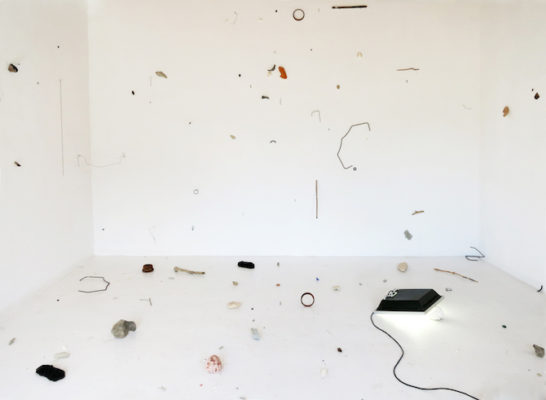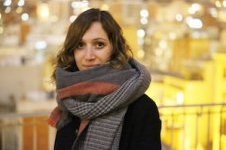Search
To search for an exact match, type the word or phrase you want in quotation marks.
A*DESK has been offering since 2002 contents about criticism and contemporary art. A*DESK has become consolidated thanks to all those who have believed in the project, all those who have followed us, debating, participating and collaborating. Many people have collaborated with A*DESK, and continue to do so. Their efforts, knowledge and belief in the project are what make it grow internationally. At A*DESK we have also generated work for over one hundred professionals in culture, from small collaborations with reviews and classes, to more prolonged and intense collaborations.
At A*DESK we believe in the need for free and universal access to culture and knowledge. We want to carry on being independent, remaining open to more ideas and opinions. If you believe in A*DESK, we need your backing to be able to continue. You can now participate in the project by supporting it. You can choose how much you want to contribute to the project.
You can decide how much you want to bring to the project.

The idea of silence is paradoxical. Most of us have come to terms with John Cage’s 4’33″. We swallowed the idea that silence doesn’t exist thanks to the story he told us, that even in an echoless chamber we are able to hear the noises made by the organs of our body. A poor old body that we stopped listening to a long time ago. A body we’ve silenced in order to obsessively contemplate it. What remains of silence for those of us who have ceased to believe in the absolute?
In the fifties, mathematician and engineer Claude E. Shannon, considered the father of information theory, published some of his studies on noise. [1] Shannon explained the influence that the technical features of the media have on the information they transmit. What he was saying was that the traces of the media are registered on the body of the information transmitted, so that the content sent by the emitter is transformed by the time it reaches the receiver. In fact, at certain moments the author was slightly more radical and spoke directly of mistakes, stating that ’During transmission the noise introduces errors’ (in the content of the information conveyed). The objective of many of those studies was to calculate the effects of noise in numbers in order to reduce it or, in the best of cases, eliminate it.
In 2011 artist and theoretician of glitch Rosa Menkman commented on Shannon’s mathematical theory, detailing that noise provides data on the relationships between the agents implicit in the process of transmission. [2] Menkman stresses the need for this factor in order to contextualise the information conveyed, and adds that the circumstantial conditions of each transmission process, such as cultural and linguistic considerations, also act as noise. In order to understand this we could think of the differences between the noises that we might hear listening to 4’33’’ if it were presented in culturally diverse contexts. Even though we might perhaps calculate such noises (that we could qualify as cultural, to distinguish them from the technical noises described by Shannon), compiling them by means of sensors and translating them into statistics in order to deduce generic patterns, I’m not sure whether these elements arouse the interest of the engineers and mathematicians devoted to developing Information and Communications Technology (ICT). I have the impression that the tasks of reducing or eliminating the traces of cultural noise are assigned to professionals of other fields. Who works to attain a background silence?
The story behind the installation Ruido blanco (White Noise) that artist Julia Llerena presented last May at Addaya art centre in Alaró makes me think that the elimination of cultural noises and the search for a background silence are often mediated by seemingly harmless actions, such the gesture of painting a wall. Addaya regularly welcomes artists in residence and offers them workshops. When Llerena arrived at the centre she was assigned a studio whose walls and floor had just been painted white and were apparently spotless. The artist discovered that the layer of white paint didn’t quite succeed in removing all the traces of what had occurred in the space before her arrival. Every mark was like a fossil hidden by the paint, cloaked in silence, novelty and neutrality to conceal the past. But Llerena heard the echoes and through Ruido blanco entered into dialogue with that past, adding to each of the marks branches and stones that she gathered during her trips around the island of Majorca.
It would be bold though perhaps inconsiderate to say that the member of staff at Addaya who decided to paint the walls white to welcome each new artist resident was acting as a censor. In other more fragile contexts, the gesture of silencing the noise made by others to give way to a new leading voice could be problematic. If to remain silent is a right, when certain expressions are silenced by order of an authority, we could speak of censorship. One example of this is the case described by Chicana poet Gloria Anzaldúa in Borderlands/La Frontera (1989) when she mentions the courses designed by Chicano students in certain universities of south-west America where they were taught to speak American English without a ’Chicano accent’. [3]
Be that as it may, censorship can be articulated more discretely although this doesn’t make it less violent for those who suffer it. Such is the case of the migrants who cross the Mediterranean from south to north who, upon reaching the coasts of Europe, see how they immediately become ’refugees’ and their experiences become the object of translations or interpretations voiced in the leading Western media. In 2012, Lorena Carbonara and Annarita Taronna, members of S/Murare il Mediterraneo research group at the University of Studies in Bari, analysed the language used by the media to describe the Mediterranean migratory crossings. [4] They found headlines such as ’The Tempest / Boat-people / 20.000 Tunisian migrants washed up on the Italian island of Lampedusa / Italy is confronted by a bigger wave / The flow of migrants / Migration flows / The human flows / A wave of rebellion began sweeping across North Africa’, among many others, that led them to denounce the fact that none of those experiences were explained in the words of the actual migrants.
When they arrived at the European coasts and became refugees, they had to adopt the language we use to refer to them. Their voices are silenced and very often, filled with good intentions, silence is what we think they deserve. The exhibition entitled A la vora de la mar (By the Sea), curated by musicologist Oriol Rossinyol for Barcelona’s Museu Marítim this summer, presented a number of musical instruments of different Mediterranean regions. The show revealed the similarities between the instruments over the course of time, denoting the idea of one and the same Mediterranean culture. A small area dedicated to the contemporary age contains a photograph of a small boat full of migrants, like those we come across from time to time in the media. Here, the object that accompanies the photograph is not an instrument but an orange life jacket. Due precisely to the fact that it isn’t an instrument, far from awakening in me an idea of silence, it conveys several connotations, a noise that, like the other instruments in the show, betrays the relations, rhythms, harmonies and complexity characterising the Mediterranean today. It would appear, therefore, that noise has a political quality, as pointed out by translator África Vidal Claramonte in the book Dile que le he escrito un ’Blues’. Del texto como partitura a la partitura como traducción en la literatura latinoamericana, in which she reflects on the role played by cultural noise in the processes of literary translation. [5] Each language is indeed accompanied by a series of noises that, like Anzaldúa’s ’Chicano accent’, ensure that the same words have different meanings for different people, and that silences are filled with sounds.
To remain silent is a right. Personally, day by day I am less able to fill the silences of others with words of my own because I am deafened by the noises they contain.
[1] Claude E. Shannon, ’A Mathematical Theory of Communication’, The Bell System Technical Journal (1948), vol. 27, pp. 237-423, 623-656, July, October.
[2] Rosa Menkman, The Glitch Moment(um), Institute of Network Cultures, Amsterdam, 2011.
[3] Gloria Anzaldúa, Borderlands/La Frontera, Aunt Lute Books, San Francisco, 1989.
[4] Lorena Carbonara and Annarita Taronna, ’In search of New Sea(e)scapes: The Metaphors of The Mediterranean From Mythological to Contemporary Narratives’, Democracy and Difference: The US in Multidisciplinary and Comparative Perspectives, Editrici Università degli Studi di Trento, Trento, 2012, pp. 301-307.
[5] África Vidal Claramonte, Dile que le he escrito un ’Blues’. Del texto como partitura a la partitura como traducción en la literatura latinoamericana, Iberoamericana, Madrid, 2017.

Anna Dot was born on a Sunday in April. She is from Torelló and works between two worlds, worlds that she cannot perceive as being in any way separate: one of artistic production and one of reflection, writing about contexts of art.
"A desk is a dangerous place from which to watch the world" (John Le Carré)